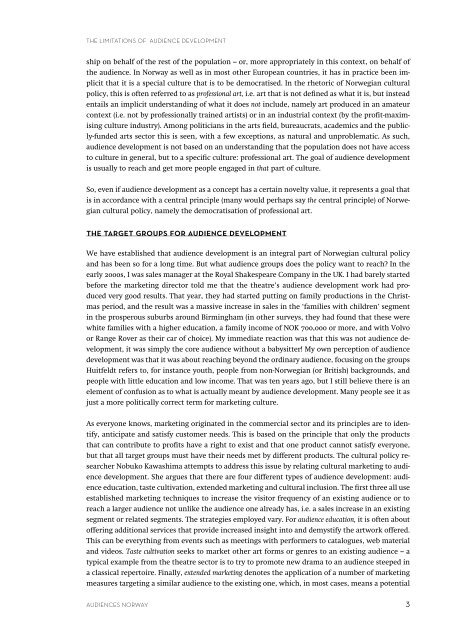the limitations of audience development - Arts And Audiences
the limitations of audience development - Arts And Audiences
the limitations of audience development - Arts And Audiences
You also want an ePaper? Increase the reach of your titles
YUMPU automatically turns print PDFs into web optimized ePapers that Google loves.
The limiTaTions <strong>of</strong> <strong>audience</strong> developmenT<br />
ship on behalf <strong>of</strong> <strong>the</strong> rest <strong>of</strong> <strong>the</strong> population – or, more appropriately in this context, on behalf <strong>of</strong><br />
<strong>the</strong> <strong>audience</strong>. In Norway as well as in most o<strong>the</strong>r European countries, it has in practice been implicit<br />
that it is a special culture that is to be democratised. In <strong>the</strong> rhetoric <strong>of</strong> Norwegian cultural<br />
policy, this is <strong>of</strong>ten referred to as pr<strong>of</strong>essional art, i.e. art that is not defined as what it is, but instead<br />
entails an implicit understanding <strong>of</strong> what it does not include, namely art produced in an amateur<br />
context (i.e. not by pr<strong>of</strong>essionally trained artists) or in an industrial context (by <strong>the</strong> pr<strong>of</strong>it-maximising<br />
culture industry). Among politicians in <strong>the</strong> arts field, bureaucrats, academics and <strong>the</strong> publicly-funded<br />
arts sector this is seen, with a few exceptions, as natural and unproblematic. As such,<br />
<strong>audience</strong> <strong>development</strong> is not based on an understanding that <strong>the</strong> population does not have access<br />
to culture in general, but to a specific culture: pr<strong>of</strong>essional art. The goal <strong>of</strong> <strong>audience</strong> <strong>development</strong><br />
is usually to reach and get more people engaged in that part <strong>of</strong> culture.<br />
So, even if <strong>audience</strong> <strong>development</strong> as a concept has a certain novelty value, it represents a goal that<br />
is in accordance with a central principle (many would perhaps say <strong>the</strong> central principle) <strong>of</strong> Norwegian<br />
cultural policy, namely <strong>the</strong> democratisation <strong>of</strong> pr<strong>of</strong>essional art.<br />
<strong>the</strong> target groups for <strong>audience</strong> <strong>development</strong><br />
We have established that <strong>audience</strong> <strong>development</strong> is an integral part <strong>of</strong> Norwegian cultural policy<br />
and has been so for a long time. But what <strong>audience</strong> groups does <strong>the</strong> policy want to reach? In <strong>the</strong><br />
early 2000s, I was sales manager at <strong>the</strong> Royal Shakespeare Company in <strong>the</strong> UK. I had barely started<br />
before <strong>the</strong> marketing director told me that <strong>the</strong> <strong>the</strong>atre’s <strong>audience</strong> <strong>development</strong> work had produced<br />
very good results. That year, <strong>the</strong>y had started putting on family productions in <strong>the</strong> Christmas<br />
period, and <strong>the</strong> result was a massive increase in sales in <strong>the</strong> ‘families with children’ segment<br />
in <strong>the</strong> prosperous suburbs around Birmingham (in o<strong>the</strong>r surveys, <strong>the</strong>y had found that <strong>the</strong>se were<br />
white families with a higher education, a family income <strong>of</strong> NOK 700,000 or more, and with Volvo<br />
or Range Rover as <strong>the</strong>ir car <strong>of</strong> choice). My immediate reaction was that this was not <strong>audience</strong> <strong>development</strong>,<br />
it was simply <strong>the</strong> core <strong>audience</strong> without a babysitter! My own perception <strong>of</strong> <strong>audience</strong><br />
<strong>development</strong> was that it was about reaching beyond <strong>the</strong> ordinary <strong>audience</strong>, focusing on <strong>the</strong> groups<br />
Huitfeldt refers to, for instance youth, people from non-Norwegian (or British) backgrounds, and<br />
people with little education and low income. That was ten years ago, but I still believe <strong>the</strong>re is an<br />
element <strong>of</strong> confusion as to what is actually meant by <strong>audience</strong> <strong>development</strong>. Many people see it as<br />
just a more politically correct term for marketing culture.<br />
As everyone knows, marketing originated in <strong>the</strong> commercial sector and its principles are to identify,<br />
anticipate and satisfy customer needs. This is based on <strong>the</strong> principle that only <strong>the</strong> products<br />
that can contribute to pr<strong>of</strong>its have a right to exist and that one product cannot satisfy everyone,<br />
but that all target groups must have <strong>the</strong>ir needs met by different products. The cultural policy researcher<br />
Nobuko Kawashima attempts to address this issue by relating cultural marketing to <strong>audience</strong><br />
<strong>development</strong>. She argues that <strong>the</strong>re are four different types <strong>of</strong> <strong>audience</strong> <strong>development</strong>: <strong>audience</strong><br />
education, taste cultivation, extended marketing and cultural inclusion. The first three all use<br />
established marketing techniques to increase <strong>the</strong> visitor frequency <strong>of</strong> an existing <strong>audience</strong> or to<br />
reach a larger <strong>audience</strong> not unlike <strong>the</strong> <strong>audience</strong> one already has, i.e. a sales increase in an existing<br />
segment or related segments. The strategies employed vary. For <strong>audience</strong> education, it is <strong>of</strong>ten about<br />
<strong>of</strong>fering additional services that provide increased insight into and demystify <strong>the</strong> artwork <strong>of</strong>fered.<br />
This can be everything from events such as meetings with performers to catalogues, web material<br />
and videos. Taste cultivation seeks to market o<strong>the</strong>r art forms or genres to an existing <strong>audience</strong> – a<br />
typical example from <strong>the</strong> <strong>the</strong>atre sector is to try to promote new drama to an <strong>audience</strong> steeped in<br />
a classical repertoire. Finally, extended marketing denotes <strong>the</strong> application <strong>of</strong> a number <strong>of</strong> marketing<br />
measures targeting a similar <strong>audience</strong> to <strong>the</strong> existing one, which, in most cases, means a potential<br />
<strong>audience</strong>s norway<br />
3


